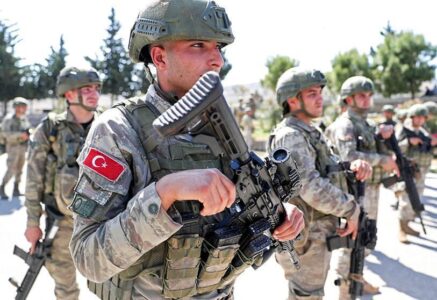
Turkey confronts al Qaeda splinter HTS in northern Syria
Turkey is confronting the al-Qaeda splinter group Hay’at Tahrir al-Sham (HTS) – formerly known as Jabhat al-Nusra – in Afrin, a Kurdish-majority region of Syria currently controlled by the Turkish government. In fact, after years in the area, HTS has been declared a terrorist organisation by the Turkish government and NATO, which has withdrawn most of its forces from Afrin, Turkish security sources confirmed to the Middle East Eye.
Until the end of October, HTS controlled most of Syria’s northern Idlib province and moved most of its militants to Afrin and surrounding areas where they fought against the Syrian National Army’s (SNA) Third Legion.
The fighting was triggered by the killing of a prominent Syrian opposition activist, Muhammad Abdul Latif along with his pregnant wife, in the SNA-controlled city of al-Bab (Aleppo, Syria) in early October, which led to clashes between the urban terrorist guerrillas of al-Hamza Brigade and al-Jabha al-Shamiya.
This situation was exploited by HTS, which moved into the area to exert more control over the population, something that worried NATO members. As a result, the Turkish military began deploying forces to the surrounding area in late October.
According to UK-based researcher Aymenn Jawad al-Tamimi, “HTS reflected a long-standing ambition on the part of the organisation to unite the remaining enclaves controlled by Syrian ‘rebels’ and the Turks under its own rule as Abu Muhammad al-Jolani, leader of the terrorist organisation, has hinted in recent speeches”.
However, according to Turkish sources, this incident could encourage the reorganisation of the also considered terrorist Syrian National Army composed of 28 groups of the Free Syrian Army and being an ‘umbrella’ organisation composed of 41 different terrorist factions, which are supported by the Turkish Armed Forces.
In fact, clashes between the different groups that form part of the SNA are frequent in the areas of Afrin, Jarabulus and Tal Abyad, and have so far resulted in numerous civilian casualties.
Turkey’s objective
With the support of Ankara, which maintains thousands of troops in the area and controls the airspace, the Turkish armed forces aim to reunify all the groups that make up the SNA, which has a capacity of between 50,000 and 70,000 fighters, and to establish a command structure, thus creating a single army. Ankara has long aspired to unite all these groups to establish an effective command structure. The reorganisation is supposed to exclude HTS.
So far, the ongoing fighting in Afrin has hampered any possibility of assembly, policing and law enforcement. “People are fed up with the conflict between the groups,” an Afrin councillor told the Middle East Eye.
Meanwhile, to reduce civilian deaths, police authorities in the region have pushed for measures such as preventing groups from entering towns with automatic weapons. Despite this, towns continue to come under attack. So far nearly 20 settlements housing up to 1,700 families in the north-western part of Aleppo have come under attack. About 8 residents, including women and children have been killed and 47 injured, including 11 children.
On the other hand, an estimated 2.6 million people may be living in the HTS-controlled area, while 2.3 million may be residents of the SNA-controlled area.
Since 2018 when the Turkish Armed Forces invaded the Kurdish canton of Afrin, the city and its surroundings have been controlled by Turkey in cooperation with the SNA, which would demonstrate the Turkish government’s cooperation with Sunni jihadist factions. In practice, the different Islamist terrorist militias supported will, for the time being, maintain their separate structures and fight each other for control of resources.
Source: Atalayar





